DRIVING IN SACRAMENTO
Everything You Need To Know
Sacramento, the capital of California, is nestled in between the Sacramento River and the American River. Sacramento is known as America’s “Farm-to-Fork,” with over forty local farmer’s markets filled with delicious food and local produce, especially during those summer days. Both tourists and locals are drawn to exploring the historical attractions, parks, and museums, so understanding the best ways to get around safely is essential! This guide describes all of the best places to visit, problem areas where accidents happen, and the best ways to get around.
CASES WE HANDLE
Major Sacramento Highways and Roads
California’s state highway system has been around since 1896 when California took over the Lake Tahoe Wagon Road, now known as US 50. In 1912, California voters approved having 3000 miles of additional roadways built, leading to the dense highway system that exists in California today. In Sacramento specifically, the major highways and roads include:
Other major roads and freeways include California 65, California 113, California 104, and California 193.
With the intricacies of the California roadway system and its many state and country roads, drivers should find ease in making travel arrangements and make the most of their time in the city. There are many things both tourists and locals can do while in Sacramento.
I-5 (West Side Freeway)
This freeway parallels the Sacramento River as it enters the city. I-5 acts as the major north-south pathway for goods and services moving along the West Coast. This is also the road responsible for guiding passengers from places like San Diego and Los Angeles to Sacramento and its growing suburbs, such as Antelope and Carmichael. I-5 is notorious for causing significant traffic delays, prompting the city of Sacramento to debate whether they should relocate the highway or create a bypass around the city.
I-80 (former US 40)
This is the area’s main east-west route, connecting Sacramento to the San Francisco Bay Area, and an easy connection to San Jose. This route formerly followed Business Loop I-80 directly into the city; however, the city rerouted the loop in the 1980s to follow the old Interstate 880 around Sacramento towards the north.
Business Loop I-80
This freeway is the original I-80 route prior to the mid-1980s. Business Loop I-80 is known as the hidden Interstate 305 between I-80 in West Sacramento and California 99.
US 50
This freeway parallels the Sacramento River as it enters the city. I-5 acts as the major north-south pathway for goods and services moving along the West Coast. This is also the road responsible for guiding passengers from places like San Diego and Los Angeles to Sacramento and its growing suburbs, such as Antelope and Carmichael. I-5 is notorious for causing significant traffic delays, prompting the city of Sacramento to debate whether they should relocate the highway or create a bypass around the city.
California 99 (former US 99)
This road approaches Sacramento from the south, joining with Business Loop I-80, seamlessly merging into I-5 northbound. This freeway is challenging to locate without a map.
California 16
This road is a split route, with the western part connecting California 20 in Colusa County with I-5 in Woodland. The eastern part begins at its connection with US 50 and continues southeast toward the Gold Country.
California 84
California 84 is Jefferson Boulevard, which is a north-south road that leads from the delta north in West Sacramento.
California 160
This is now a split route, with a portion running through downtown decommissioned in the early 2000s. The northern part is known as the North Sacramento Freeway, and the southern part follows the Sacramento River through Freeport Boulevard en route to the California Delta.
California 275 (Tower Bridge)
This road crosses the Sacramento River, linking the Tower Bridge Gateway in West Sacramento to the Capitol Mall in Downtown Sacramento. The entire road is only 0.138 miles.
This freeway parallels the Sacramento River as it enters the city. I-5 acts as the major north-south pathway for goods and services moving along the West Coast. This is also the road responsible for guiding passengers from places like San Diego and Los Angeles to Sacramento and its growing suburbs, such as Antelope and Carmichael. I-5 is notorious for causing significant traffic delays, prompting the city of Sacramento to debate whether they should relocate the highway or create a bypass around the city.
This is the area’s main east-west route, connecting Sacramento to the San Francisco Bay Area, and an easy connection to San Jose. This route formerly followed Business Loop I-80 directly into the city; however, the city rerouted the loop in the 1980s to follow the old Interstate 880 around Sacramento towards the north.
This freeway is the original I-80 route prior to the mid-1980s. Business Loop I-80 is known as the hidden Interstate 305 between I-80 in West Sacramento and California 99.
This freeway parallels the Sacramento River as it enters the city. I-5 acts as the major north-south pathway for goods and services moving along the West Coast. This is also the road responsible for guiding passengers from places like San Diego and Los Angeles to Sacramento and its growing suburbs, such as Antelope and Carmichael. I-5 is notorious for causing significant traffic delays, prompting the city of Sacramento to debate whether they should relocate the highway or create a bypass around the city.
This road approaches Sacramento from the south, joining with Business Loop I-80, seamlessly merging into I-5 northbound. This freeway is challenging to locate without a map.
This road is a split route, with the western part connecting California 20 in Colusa County with I-5 in Woodland. The eastern part begins at its connection with US 50 and continues southeast toward the Gold Country.
California 84 is Jefferson Boulevard, which is a north-south road that leads from the delta north in West Sacramento.
This is now a split route, with a portion running through downtown decommissioned in the early 2000s. The northern part is known as the North Sacramento Freeway, and the southern part follows the Sacramento River through Freeport Boulevard en route to the California Delta.
This road crosses the Sacramento River, linking the Tower Bridge Gateway in West Sacramento to the Capitol Mall in Downtown Sacramento. The entire road is only 0.138 miles.
Popular Destination in Sacramento
California State Railroad
Museum This historic museum is more than 200,000 square feet and is among the world’s largest railway museums. When visiting this landmark, guests will find restored steam locomotives and railway coaches dating from 1862 to 1944. You can find this museum just west of I-5, on the east side of the Sacramento River:
Sacramento State Capitol Museum
This structure was built in the 1860s and is one of the most visited attractions in Sacramento showcasing gorgeous Neoclassical architecture. Here, visitors can also see colorful gardens, tall palm trees, and many other tree and plant species from around the world on the grounds. Inside and out, this one of the most beautiful Capitol buildings in the United States. The building is in the heart of downtown Sacramento, just south of the area known as the “Mansion Flats” and past the Tower Bridge:
Old Sacramento
Old Sacramento spans over eight blocks, tallying up to a whopping 28 acres. The area is lined with over 50 historic buildings all across the city’s waterfront and is designated as a National Historic Landmark. The area also includes the Old Sacramento State Historic Park, which has some Gold Rush-era structures, such as the Eagle Theater, built in 1849. The historic Old Sacramento buildings continue to be occupied by over 125 locally-owned shops, hotels, restaurants, and museums, making it a perfect destination for both tourists and locals. Some activities in Old Sacramento include taking a horse-drawn carriage ride, hopping on a riverboat excursion, or climbing onboard a vintage locomotive.
Crocker Museum of Art
This museum holds an incredible collection of art ranging from the Gold-Rush era to the present day. Exhibits include European paintings, drawings, and American photography. The museum is named after Margaret Crocker who donated the original collection, creating the backbone of the museum. The museum’s main building is the Italianate Victorian-era mansion, known as a California historical landmark, and it’s listed on the National Register of Historic Places. The museum was founded in 1885, making it the oldest art museum west of the Mississippi River. Located south of the Tower Bridge, just east of I-5, this museum is a must-see when in Sacramento:
Sutter’s Fort State Historic Park
Sutter’s Fort was a 19th-century agricultural and trade colony that sits on what was the first outpost of the ‘white man’ in California. Johann August Sutter, a German-Swiss immigrant, built his house the same year and it has since been restored to its original style. You can find this area just west of the Elvas Freeway and north of I-5:
California Automobile Museum
This museum is home to more than 120 vintage automobiles ranging from 1885 to 2011. The collection includes Ford models from 1904 to 1969 and demonstrates the development of American cars over the past 120 years. The museum also has special exhibits throughout the year focusing on different themes, such as California car culture, pickup trucks, road trips, and camping. This museum sits just off of the intersection of I-5 and I-80, east of the Sacramento River.
Sacramento Zoo
Families, solo travelers, and animal lovers alike will love visiting the Sacramento Zoo, which is home to more than 500 exotic animals and more than 200 reptiles. The zoo spans over 14 acres and includes 14 various aviaries, making it home to 35 bird species. The zoo seeks to support wildlife protection, involving both local and international conservation projects. The zoo sits east of the I-5 and just north of Sutterville Road:
Cathedral of the Blessed Sacrament
This landmark was built in 1889 and has since become a spiritual center. The architecture is reminiscent of a Spanish colonial church with its multi-towered facade and Neoclassical interior. The Cathedral hosts Eucharist celebrations (Mass services) every day and provides ceremonies for weddings, baptisms, and other occasions. The Cathedral is located northwest of the California State Capitol Park in Downtown Sacramento, northeast of the Tower Bridge:
American River Bike Trail/Jedediah Smith Memorial Trail
This well-maintained paved path winds through California’s best, with beautiful shady oak trees lining the path. It is one of the most popular walking and hiking trails in Sacramento, spanning 32 miles and paralleling the American River. This trail is perfect for those who love to cycle, jog, walk, or ride horseback. Visitors will also love the great spots for fishing and picnicking within the park.
West Wind Drive-In
This retro drive-in movie theater shows the latest releases on large screens and allows visitors to listen by playing the sound through FM radio. While there, visitors can enjoy a relaxing evening with delicious snacks from the concession stand. For weekly showtimes and to purchase tickets, head to their online box office. You can put your email in ahead of time for exclusive coupons and a calendar of upcoming events.
Leland Stanford Mansion State Historic Park
This Victorian-era architecture recently underwent renovations costing $22 million. It expands over 19,000 square feet with 17-foot ceilings and ornate woodwork. The mansion is in downtown Sacramento, offers tours for the public, is used for state functions, and hosts international dignitaries. Also known as just the Stanford Mansion, you can find this historic site just south of the Tower Bridge:
California State Railroad
Museum This historic museum is more than 200,000 square feet and is among the world’s largest railway museums. When visiting this landmark, guests will find restored steam locomotives and railway coaches dating from 1862 to 1944. You can find this museum just west of I-5, on the east side of the Sacramento River:
Sacramento State Capitol Museum
This structure was built in the 1860s and is one of the most visited attractions in Sacramento showcasing gorgeous Neoclassical architecture. Here, visitors can also see colorful gardens, tall palm trees, and many other tree and plant species from around the world on the grounds. Inside and out, this one of the most beautiful Capitol buildings in the United States. The building is in the heart of downtown Sacramento, just south of the area known as the “Mansion Flats” and past the Tower Bridge:
Old Sacramento
Old Sacramento spans over eight blocks, tallying up to a whopping 28 acres. The area is lined with over 50 historic buildings all across the city’s waterfront and is designated as a National Historic Landmark. The area also includes the Old Sacramento State Historic Park, which has some Gold Rush-era structures, such as the Eagle Theater, built in 1849. The historic Old Sacramento buildings continue to be occupied by over 125 locally-owned shops, hotels, restaurants, and museums, making it a perfect destination for both tourists and locals. Some activities in Old Sacramento include taking a horse-drawn carriage ride, hopping on a riverboat excursion, or climbing onboard a vintage locomotive.
Crocker Museum of Art
This museum holds an incredible collection of art ranging from the Gold-Rush era to the present day. Exhibits include European paintings, drawings, and American photography. The museum is named after Margaret Crocker who donated the original collection, creating the backbone of the museum. The museum’s main building is the Italianate Victorian-era mansion, known as a California historical landmark, and it’s listed on the National Register of Historic Places. The museum was founded in 1885, making it the oldest art museum west of the Mississippi River. Located south of the Tower Bridge, just east of I-5, this museum is a must-see when in Sacramento:
Sutter’s Fort State Historic Park
Sutter’s Fort was a 19th-century agricultural and trade colony that sits on what was the first outpost of the ‘white man’ in California. Johann August Sutter, a German-Swiss immigrant, built his house the same year and it has since been restored to its original style. You can find this area just west of the Elvas Freeway and north of I-5:
California Automobile Museum
This museum is home to more than 120 vintage automobiles ranging from 1885 to 2011. The collection includes Ford models from 1904 to 1969 and demonstrates the development of American cars over the past 120 years. The museum also has special exhibits throughout the year focusing on different themes, such as California car culture, pickup trucks, road trips, and camping. This museum sits just off of the intersection of I-5 and I-80, east of the Sacramento River.
Sacramento Zoo
Families, solo travelers, and animal lovers alike will love visiting the Sacramento Zoo, which is home to more than 500 exotic animals and more than 200 reptiles. The zoo spans over 14 acres and includes 14 various aviaries, making it home to 35 bird species. The zoo seeks to support wildlife protection, involving both local and international conservation projects. The zoo sits east of the I-5 and just north of Sutterville Road:
Cathedral of the Blessed Sacrament
This landmark was built in 1889 and has since become a spiritual center. The architecture is reminiscent of a Spanish colonial church with its multi-towered facade and Neoclassical interior. The Cathedral hosts Eucharist celebrations (Mass services) every day and provides ceremonies for weddings, baptisms, and other occasions. The Cathedral is located northwest of the California State Capitol Park in Downtown Sacramento, northeast of the Tower Bridge:
American River Bike Trail/Jedediah Smith Memorial Trail
This well-maintained paved path winds through California’s best, with beautiful shady oak trees lining the path. It is one of the most popular walking and hiking trails in Sacramento, spanning 32 miles and paralleling the American River. This trail is perfect for those who love to cycle, jog, walk, or ride horseback. Visitors will also love the great spots for fishing and picnicking within the park.
West Wind Drive-In
This retro drive-in movie theater shows the latest releases on large screens and allows visitors to listen by playing the sound through FM radio. While there, visitors can enjoy a relaxing evening with delicious snacks from the concession stand. For weekly showtimes and to purchase tickets, head to their online box office. You can put your email in ahead of time for exclusive coupons and a calendar of upcoming events.
Leland Stanford Mansion State Historic Park
This Victorian-era architecture recently underwent renovations costing $22 million. It expands over 19,000 square feet with 17-foot ceilings and ornate woodwork. The mansion is in downtown Sacramento, offers tours for the public, is used for state functions, and hosts international dignitaries. Also known as just the Stanford Mansion, you can find this historic site just south of the Tower Bridge:
Getting Around Sacramento and Public Transportation
Getting around any city, especially an unfamiliar one, can be a frustrating experience between traffic, dealing with other drivers, and not knowing where you are going. While driving in Sacramento is an easy way to get around if you know where you are going, or have the patience to learn the city’s roads, there are other ways to get around Sacramento as well.
Additionally, taxis and city buses allow you to easily navigate the city with experienced drivers. Many hotels also offer shuttles to top destinations within Sacramento, including the ones listed above. If you want to travel like a local, or are a local, you can hop on the Sacramento Regional Transit (SacRT). The SacRT is an excellent public transportation system that operates over 80 bus routes, has 43 miles of light rail services and 52 light rail stations. In total, it runs within a 400-square-mile service area throughout Sacramento County. The SacRT services Sacramento and its suburbs including Citrus Heights, Folsom, Elk Grove, and Rancho Cordova.
Another popular way to get around Sacramento is by bike. The company, Bike Sacramento Bicycle rental is a great place to rent a bike and explore Sacramento. It’s located adjacent to the American River Bike Trail on 1050 Front Street and is also close to the downtown (Old Sacramento) area. And if you want to get adventurous and travel by boat, the River Otter Water Taxi can take you down to the Sacramento River and back.
Finally, like many other cities, Sacramento has welcomed Bird, Lyft, and Lime scooters into the city. Always wear a helmet, though, as these scooters can get up to around 20 miles per hour!
The Most Dangerous Roads and Intersections in Sacramento
In California, overall traffic fatalities decreased from 3,884 fatalities in 2017 to 3,563 in 2018. However, dangerous intersections still exist, and many accidents continue to happen each year.
To see the locations of major traffic hotspots in and around Sacramento, take a look at the maps below with and without hotspot indicators:
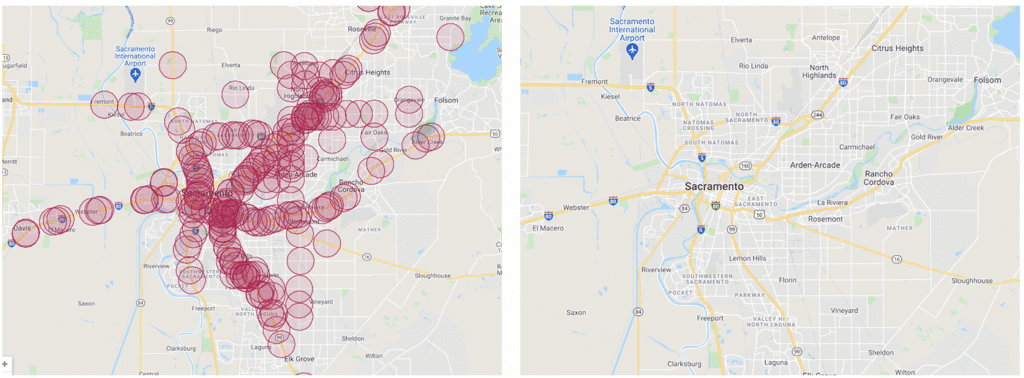
The darker red circles in the first image represent more severe accidents, which also indicate areas with slower traffic and congestion. With the maps, we can also see that the most heavily trafficked and dangerous driving areas lie along I-5 and Highway 99 in downtown Sacramento.
Two locations are especially alarming, and that is where Highway 99 meets US highway 50 and I-80 downtown. North of the city, we can also see that there is a lot of issues happening where I-80 meets highway 244.
Areas known to be dangerous include the intersection of Arena Boulevard and Truxel Road where many accidents occur. At this intersection, you will find the Natomas Crossing Business Center as well as the Consulate General of Mexico. The intersection at I St and 12st Street, just one street over from Sacramento City Hall, and a few streets north of the historic Cathedral of the Blessed Sacrament is also known to have many accidents.
Additionally, below you can see the average time it takes to drive 30 minutes to and from our office close to downtown Sacramento. The 30-minute drive to work is known as the Marchetti Constant and is something that is hardwired into humans. The average person takes 30 minutes to commute to work, no matter the means it takes to get there or the amount of traffic of the city they live in.
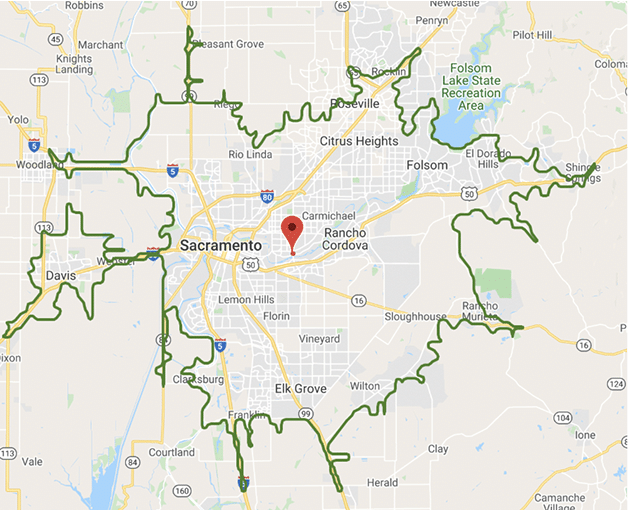
But the 30-minute drive time isn’t always a reality. Below, you can see examples of a 60 minute drive time to/from our office. Both instances are great measures of urban sprawl and indicate where and how traffic moves throughout Sacramento.
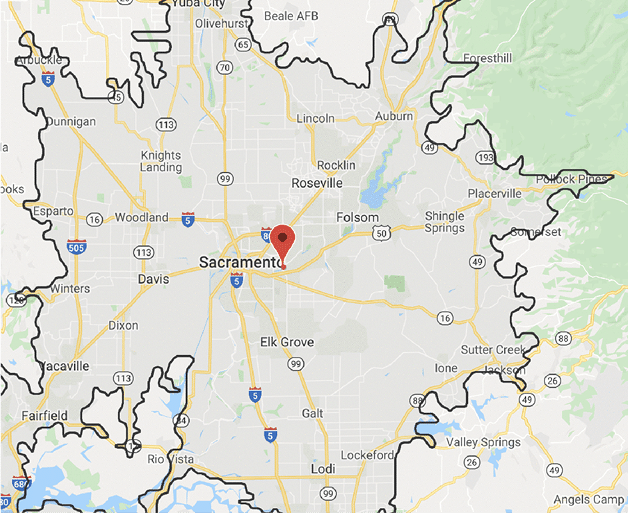
The Most Dangerous Roads and Intersections in Sacramento
But the 30-minute drive time isn’t always a reality. Below, you can see examples of a 60 minute drive time to/from our office. Both instances are great measures of urban sprawl and indicate where and how traffic moves throughout Sacramento.
You can click on the various geographic areas listed on the website, including:
- Downtown Sacramento
- East Sacramento, Tahoe
- Park, Elmhurst, River Park,
- College Greens, College Glen
- Land Park
- River District
- South Sacramento
- North Sacramento
- Natomas
Sacramento Driving Laws
Most cities have similar laws pertaining to drivers, such as all drivers and passengers must wear seatbelts and abide by the speed limits. However, both state and local laws apply to other driving requirements, which you can learn about in Sacramento’s Drive Safe Sacramento. This program is an exclusive driver’s training program for people in Sacramento to learn how to become a safe, defensive driver.
The relevant Sacramento and California driving laws include:
Phone Laws
In California, drivers cannot use a cell phone or similar electronic communication device if the device is in the driver’s hand while driving. You can only use the device in a hands-free manner, such as on speaker voice, Bluetooth, or voice commands. The crucial element of the law is that you can never use the device while holding it. One caveat to the law is that if a driver is under 18 years old, then that driver cannot use a cell phone for any reason – even in a hands-free manner.
Motorcycle Laws
- Helmets – California Vehicle Code (CVC) 27803 pertains to motorcycle drivers and requires drivers and riders to always wear helmets.
- Mirrors – CVC 26709 states that motorcycles must have both right and left mirrors.
- Headlights – Further, drivers must use headlights at all times, even during the day, if the motorcycle was built in 1978 or later.
- Age – Regarding age, if the driver is younger than 21 years old, then the driver must first have a learner’s permit for six months before applying for the motorcycle license.
- Lane-Splitting – In August 2016, lane splitting became legal in California. Also known as lane sharing, lane splitting is when a motorcyclist rides between lanes of traffic when traffic is moving slowly or is stopped. Though lane-splitting is legal, all motorcyclists should take extreme caution when doing so.
International Drivers’ Laws
In California, in general, foreign visitors with a valid driver’s license from a foreign country can legally drive in the state of California without having to get a California driver’s license or international driving permit (“IDP”). However, the driver must meet the following requirements:
- They are 18 years old or older;
- The country where they reside lawfully issued the license to them; and
- The license they have covers the type of vehicle they will drive or are driving in California (i.e., truck, car, motorcycle, etc.).
Further, it is essential to note that while the state might not require the driver to have an IDP, some car rental agencies may require the IDP as well as the foreign license.
In California, you can receive your driver’s license at 16 years old. Most high school students begin the process their sophomore year. This includes both driver’s education and driver training in order to be eligible to take the driving test. If you are a minor, you must have had your learner’s permit for at least six months before you can receive your driver’s license. If you are not a minor and you are seeking to get your license in Sacramento, you do not have to start from square one if you are already a licensed driver in another state. You simply have to go to the California DMV, complete the driver’s license application, provide the relevant information, have your fingerprints scanned and your photo taken, pay the license fee, take the vision exam, pass the written test, and pass the driving test.
Sacramento signed a deal in 2018 with a Silicon Valley firm to allow the firm to use downtown streets as a ‘testing ground’ for self-driving (autonomous) vehicles. The cars would be monitored by remote ‘drivers’ that were in Silicon Valley. With this allowance, drivers, bicyclists, motorcyclists, and pedestrians must be aware of the dangers of self-driving cars. While autonomous vehicles must abide by traffic laws, they can also be held liable for accidents they may cause.
Drivers must yield the right-of-way to pedestrians at marked crosswalks, or within any unmarked crosswalk at an intersection. Pedestrians must use due care for their safety, though, and the law does not allow pedestrians to suddenly leave a curb or walk or run into a vehicle’s path, which may cause an immediate hazard. The CVC addresses pedestrian laws in Sections 275, 21950, and 21955, and the Sacramento City Code addresses pedestrians in the Vehicles and Traffic regulations, Titles 10 and 12.
If you do not abide by these rules, you can cause an accident, receive a traffic ticket, or even have your driver’s license revoked.
Renting a Car in Sacramento
Renting a car while in Sacramento can be a great way to get around. Many companies offer car rentals at the airport, with the price depending on the type of car desired (i.e., Standard, Full-Size, Full-Size SUV, Premium). If you plan to drive anywhere outside of the main parts of Sacramento, such as downtown or midtown, you will likely need a car.
However, if you plan just to stay local, you can use some of the public transportation options we described in this article. To summarize, these options include:
- SacRT
- Bird, Lyft, or Lime Scooters
- Bike rentals
- Taxis
- Walking
No matter how you get around, you will surely appreciate the various options you have in Sacramento.
Parking in Sacramento
Parking in any city can be challenging. Sacramento offers parking services including free metered parking after 4:30 pm and free all-day metered parking on weekends, which can make finding parking easier. In residential areas, you may need a residential permit to park on some streets. Sacramento also offers an online reservation system called, SacPark Reservation to allow drivers to reserve a parking spot ahead of time at any City-owned garage or certified parking partner of the city.
Besides metered parking, the city also offers parking permits for non-residential areas. You can receive the following types of parking permits:
Temporary Construction Parking Permit
Emergency Permit
Delivery Permit
Valet Permit
Educational Institution Permit
Car Share Parking Permits
The city uses the application called Parkmobile to allow drivers to pay for parking sessions at specific meters and off-street parking lots by using the mobile app, web browser, or by calling (916) SAC-PARK. Parkmobile also enables the ‘pay-by-plate’ technology that allows certain parking facilities to use a system that recognizes your vehicle’s license plate and automatically charges for the payment. The Pay-By-Plate feature is available at the following locations:
With the Parkmobile app, you can also add time without having to return to your vehicle!
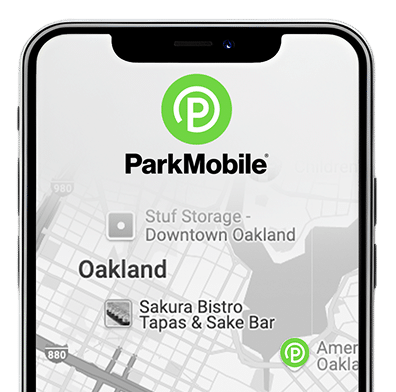
Common Things That Affect Driving in Sacramento
Sacramento drivers are notorious for not being good drivers. The City of Sacramento cites the following five traffic violations as the leading causes of accidents in Sacramento:
Also known as “tailgating,” following too closely behind the vehicle in front of you can cause severe accidents. The city quotes the ‘three-second rule’ as a guideline to help drivers avoid accidents. This rule state that you should not pass an object in front of you in less than three seconds.
As you can see on the maps above, there are many areas in Sacramento where accidents occur often. Drivers cause these accidents by failing to abide by traffic signals, such as red signal lights, failing to stop at a stop sign, pedestrian laws at crosswalks, speeding laws, or lane-changing laws.
While the country as a whole has tried to take various measures to decrease drinking and driving, many drivers still continue to do so and cause catastrophic accidents as a result.
Drivers speed for many reasons. Whether it is because they are running late, are impatient, do it for the adrenaline rush, or fail to recognize the speed limit, speeding often causes accidents in Sacramento, the rest of California, and the country.
Drivers often fail to accurately predict the amount of time and space they have when making a left turn while another vehicle is approaching head-on.
When drivers are distracted by looking at their phone screen, looking at other people, eating while driving, or any other action that can distract them from paying attention at the wheel, they often are more susceptible to causing car accidents.
Sacramento can experience heavy rainfall and wet winters. While Sacramento rarely sees snow, the heavy rain can cause more accidents in the city as the roads are slippery and drivers often have more difficulty seeing.
Any accident can be an overwhelming and frightening experience. If you are involved in an accident while in Sacramento, you should follow these steps:
In Sacramento, it is illegal to leave the scene of an accident after a crash. Therefore, always remain at the scene, especially if there are any injuries to you, passengers, or the other driver.
In Sacramento, it is illegal to leave the scene of an accident after a crash. Therefore, always remain at the scene, especially if there are any injuries to you, passengers, or the other driver.
In Sacramento, it is illegal to leave the scene of an accident after a crash. Therefore, always remain at the scene, especially if there are any injuries to you, passengers, or the other driver.
If you haven’t done so already, you should always call 9-1-1 so that a police officer can evaluate the accident scene and write up an accident report. It is vital to seek medical attention, even if you do not feel injured, as some injuries may not be apparent.
Always make sure to write down all of the information you can from the other driver. This can include name, insurance information, car information, and any other details that may be relevant.
Make sure to note everything from the accident scene so that you can provide a complete picture to the insurance companies and/or lawyers.
Take pictures of both cars and any other relevant images at the scene (such as poles that you may have hit, etc.).
Be sure to write to the contact information of anyone who can serve as a potential witness.
Before speaking to any insurance company about settlements or claims, you should consult with a knowledgeable lawyer about what your rights may be. You may be entitled to compensation
Accidents do happen, though you can be better prepared by staying calm and following the steps above.
Sacramento is an incredible city. This affordable and family-friendly destination is great for both tourists and locals alike. Indulge in the rich history and evolving contemporary culture, but be sure you plan the best ways to get around quickly and efficiently!

Personal injury and civil justice attorney Brooks Cutter is a leading advocate for consumer justice and protecting the rights of the severely injured. Brooks founded Cutter Law, P.C., with offices in Sacramento and Oakland, with…
